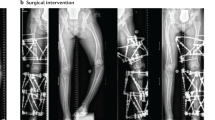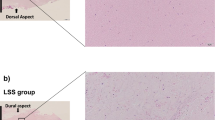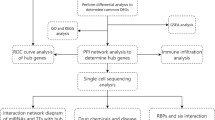Abstract
The calciotropic activity of urine from a subject with neonatal Bartter syndrome (NBS) has been partially purified using ion-exchange and gel chromatographic techniques. A bioassay using bone disk from rat calvaria was used to estimate calciotropic activity, which in the urine of the subject with NBS appears to be due to basic fibroblast growth factor (bFGF) bound to a glycosaminoglycan susceptible to heparitinase digestion. The calciotropic activity is eluted from DEAE-Sephacel and Sepharose CL-6B in a narrow band in association with metachromatic material and is destroyed by heparitinase and blocked by an antibody to bFGF. After treatment of purified preparations with heparitinase, a component that is inactive alone but develops calciotropic activity in association with heparin can be isolated by affinity chromatography on heparin-Sepharose columns. This component is recovered from the column at NaCl concentrations expected to elute bFGF and is inactivated by antibodies to bFGF. No calciotropic activity can be shown in glycosaminoglycan-containing fractions from urine from a normal boy or a normal man, but such fractions exhibit calciotropic activity if bFGF is added to the assay system. When bFGF is added to urine from either normal subject followed by ion-exchange chromatography on DEAE-Sephacel, calciotropic activity is eluted at NaCl concentrations closely similar to those found to elute calciotropic activity from the urine of the NBS subject. It appears that the abnormal findings in NBS urine are due to excess bFGF, although they could be due to some abnormality of the glycosaminoglycan component.
Similar content being viewed by others
Log in or create a free account to read this content
Gain free access to this article, as well as selected content from this journal and more on nature.com
or
Abbreviations
- bFGF :
-
basic fibroblast growth factor
- GAG :
-
glycosaminoglycan
- NBS :
-
neonatal Bartter syndrome
References
Seyberth HW, Rascher W, Schweer H, Kühl PG, Mehls O, Schärer K 1985 Congenital hypokalemia with hypercalciuria in preterm infants: a hyperprostaglandinuric tubular syndrome different from Bartter syndrome. J Pediatr 107: 694–701.
de Rovetto CR, Welch TR, Hug G, Clark KE, Bergstrom W 1989 Hypercalciuria with Bartter syndrome: evidence for an abnormality of vitamin D metabolism. J Pediatr 115: 397–404.
Shoemaker L, Welch TR, Bergstrom W, Abrams SA, Yergey AL, Vieira N 1993 Calcium kinetics in the hyperprostaglandin E syndrome. Pediatr Res 33: 92–96.
Shoemaker LR, Bergstrom W, Ragosta K, Welch TR 1998 Humoral factor in children with hyperprostaglandin E syndrome reduces bone calcium uptake in vitro. Pediatr Nephrol 12: 371–376.
Chowdhury MH, Hamada C, Dempster DW 1992 Effects of heparin on osteoclast activity. J Bone Min Res 7: 771–777.
Shaughnessy SG, Young E, Deschamps P, Hirsh J 1995 The effects of low molecular weight and standard heparin on calcium loss from fetal rat calvaria. Blood 86: 1368–1373.
Fuller K, Chambers TJ, Gallagher AC 1991 Heparin augments osteoclasts resorption-stimulating activity in serum. J Cell Physiol 147: 208–214.
Simmons HA, Raisz LG 1991 Effects of acid and basic fibroblast growth factor and heparin on resorption of cultured fetal rat long bones. J Bone Min Res 6: 1301–1305.
Tashjian AH, Voelkel EF, Lazzaro M, Singer FR, Roberts AB, Derynck R, Winkler ME, Levine L 1985 α and β human transforming growth factors stimulate prostaglandin production and bone resorption in cultured mouse calvaria. Proc Natl Acad Sci USA 82: 4535–4538.
Shoemaker LR, Bergstrom W, Welch TR, Ragosta K 1995 The role of basic fibroblast growth factor (bFGF) in heparin-induced bone resorption. Pediatr Res 37: 79A
Bergstrom WH 1992 Bone disc bioassay for calciotropic agents. J Bone Min Res 7:S244.
Ragosta KG, Bergstrom WH, Briggs DB, Brandt B 1996 Protamine and acute depletion of magnesium limit bone response to parathyroid hormone. Anesth Analg 82: 29–32.
Bett IM, Fraser GP 1958 A rapid micro method for determining serum calcium. Biochem J 68: 13P
Thompson AR, Counts RB 1976 Removal of heparin and protamine from plasma. J Lab Clin Med 88: 922–929.
Yanagishita M, Midura RJ, Hascall VC 1987 Proteoglycans: isolation and purification from tissue cultures. Methods Enzymol 138: 279–289.
Farndale RW, Sayers CA, Barrett AJ 1982 A direct spectrophotometric microassay for sulfated glycosaminoglycans in cartilage cultures. Connect Tissue Res 9: 247–248.
Oohira A, Wight TN, Bornstein P 1983 Sulfated proteoglycans synthesized by vascular endothelial cells in culture. J Biol Chem 258: 2014–2021.
Gaspodarowicz D, Cheng J, Lui GM, Baird A, Böhlent P 1984 Isolation of brain fibroblast growth factor by heparin-Sepharose affinity chromatography: identity with pituitary fibroblast growth factor. Proc Natl Acad Sci USA 81: 6963–6967.
Yayon A, Aviezer D, Safran M, Gross JL, Heldman Y, Cabilly S, Givol D, Katchalski-Katzir E 1993 Isolation of peptides that inhibit binding of basic fibroblast growth factor to its receptor from a random phage-epitope library. Proc Nat Acad Sci USA 90: 10643–10647.
Michelacci YM, Glashan RQ, Schor N 1989 Urinary excretion of glycosaminoglycans in normal and stone forming subjects. Kidney Int 36: 1022–1028.
Bashkin P, Doctrow S, Klagsbrun M, Svahn CM, Folkman J, Vlodavsky I 1989 Basic fibroblast growth factor binds to subendothelial extracellular matrix and is released by heparitinase and heparin-like molecules. Biochemistry 28: 1737–1743.
Ornitz DM, Yayon A, Flanagan JG, Svahn CM, Levi E, Leder P 1992 Heparin is required for cell-free binding of basic fibroblast growth factor to a soluble receptor and for mitogenesis in whole cells. Mol Cell Biol 12: 240–247.
Ishihara M, Tyrell DJ, Stauber GB, Brown S, Cousens LS, Stack RJ 1993 Preparation of affinity-fractionated, heparin-derived oligosaccharides and their effects on selected biological activities mediated by basic fibroblast growth factor. J Biol Chem 268: 4675–4683.
Tyrrell DJ, Ishihara M, Rao N, Horne A, Kiefer MC, Stauber GB, Lam LH, Stack RJ 1993 Structure and biological activities of a heparin-derived hexasaccharide with high affinity for basic fibroblast growth factor. J Biol Chem 268: 4684–4689.
Maccarana M, Casu B, Lindahl U 1993 Minimal sequence in heparin/heparan sulfate required for binding of basic fibroblast growth factor. J Biol Chem 268: 23898–23905.
Guimond S, Maccarana M, Olwin BB, Lindahl J, Rapraeger AC 1993 Activating and inhibitory sequences for FGF-2 (basic FGF). Distinct requirements for FGF-1, FGF-2, and FGF-4. J Biol Chem 268: 23906–23914.
Ornitz DM, Herr AB, Nilsson M, Westman J, Svahn CM, Waksman G 1995 FGF binding and FGF receptor activation by synthetic heparan-derived di- and trisaccharides. Science 268: 432–435.
Simon DB, Karet FE, Hamdan JM, Di Pietro A, Sanjad SA, Lifton RP 1996 Bartter's syndrome, hypokalaemic alkalosis with hypercalciuria, is caused by mutations in the Na-K-2Cl cotransporter NKCC2. Nature Genet 13: 183–188.
Simon DB, Karet FE, Rodriguez-Soriano J, Hamdan JH, Di Pietro A, Trachtman H, Sanjad SA, Lifton RP 1996 Genetic heterogeneity of Bartter's syndrome revealed by mutations in the K+ channel, ROMK. Nature Genet 14: 152–156.
International Collaborative Study Group for Barrter-like Syndromes 1997 Mutations in the gene encoding the inwardly-rectifying renal potassium channel, ROMK, cause the antenatal variant of Bartter syndrome: evidence for genetic heterogeneity. Hum Mol Genet 6: 17–26.
Simon DB, Bindra RS, Mansfield TA, Nelson-Williams C, Mendonca E, Stone R, Schurman S, Nayir A, Alpay H, Bakkaloglu A, Rodriguez-Soriano J, Morales JM, Sanjad SA, Taylor CM, Pilz D, Brem A, Trachtman H, Griswold W, Richard GA, John E, Lifton RP 1997 Mutations in the chloride channel gene, CLCNKB, cause Bartter's syndrome type III. Nature Genet 17: 171–178.
Schurman SJ, Bergstrom WH, Shoemaker LR, Simon DB 1998 Contrasting phenotypes of children with different Bartter's syndrome (BS) gene defects. Pediatr Res 43: 85A
Author information
Authors and Affiliations
Additional information
Supported in part by the Education and Research Fund of the Department of Pediatrics, the Department of Medicine, and the David M. Beers Endowment Fund, SUNY Health Science Center, Syracuse, NY.
Rights and permissions
About this article
Cite this article
Williams, W., Shoemaker, L., Schurman, S. et al. Conjunctive Effects of Fibroblast Growth Factor and Glycosaminoglycan on Bone Metabolism in Neonatal Bartter Syndrome. Pediatr Res 45 (Suppl 5), 726–732 (1999). https://doi.org/10.1203/00006450-199905010-00020
Received:
Accepted:
Issue date:
DOI: https://doi.org/10.1203/00006450-199905010-00020
This article is cited by
-
Bone mineral density and bone turnover in patients with Bartter syndrome
Pediatric Nephrology (2005)



